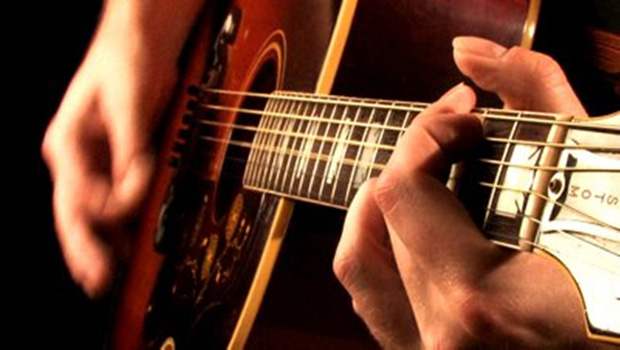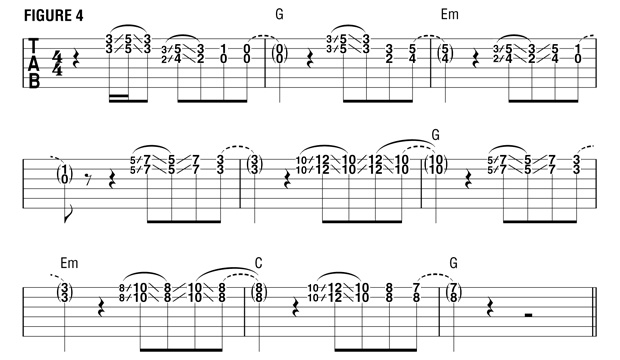Harmonizing With Fourths

As the interval between the fifth scale degree and the octave, the fourth is basic to the structure of most chords.
When used melodically, however, fourths are not nearly as versatile as thirds and sixths.
Harmonizing a scale in fourths evokes a somewhat medieval vibe—think chanting monks— which, while atmospheric, is not the most useful tool in the box.
As you’ll see, though, fourths have found a home within, of all places, R&B, soul, and funk.
On the guitar neck, fourths adapt most comfortably to pentatonic scale patterns. If you examine two specific scales, G major pentatonic and E minor pentatonic (FIGURE 1), you’ll note that while they are based on different tonics, or fundamental tones, they contain identical pitches.

Major and minor scales that share the same notes are called relative scales, and a convenient result of this relationship is that fingering patterns learned for one may also be applied to the other.
Harmonizing pentatonic scales in fourths involves the use of only two fingering shapes (FIGURE 2).
Get The Pick Newsletter
All the latest guitar news, interviews, lessons, reviews, deals and more, direct to your inbox!

In FIGURE 3 they’re put to work over a funky acoustic-friendly groove similar to that of Neil Young’s “Heart of Gold.”

The accents on beats 2 and 4, commonly called chicks, match the ubiquitous snare drum pattern known as the backbeat. On the first and third beats, mute the lower strings with the heel of your pick hand to increase the dynamic contrast.
While thirds and sixths can be used to harmonize complete melodies, fourths are usually limited to short fills. In R&B, soul and funk, these snappy little interjections turn up in all kinds of settings from ballads (the Impressions’ “People Get Ready”) to dance grooves (Earth, Wind & Fire’s “Sing a Song”).
FIGURE 4, a compendium of typical fourth-based fills, begins with a pickup phrase, a fill that precedes the downbeat. The phrasing with quick slides between notes is simultaneously slippery and percussive.

Notes that the last note of each fill resolves into the ensuing chord; effective fills create a sense of anticipation of what’s to come. The second time around, all of the fills are on the first and second strings, making it a one-finger exercise.
"Upgrading from your entry-level acoustic opens the door to an entirely new world of tonewoods, body shapes, and brands": 6 signs it's time to upgrade from your first acoustic guitar
"I'm past my prime": 5 common excuses for not learning the guitar – and 5 body and mind-boosting reasons you should
![A black-and-white action shot of Sergeant Thunderhoof perform live: [from left] Mark Sayer, Dan Flitcroft, Jim Camp and Josh Gallop](https://cdn.mos.cms.futurecdn.net/am3UhJbsxAE239XRRZ8zC8.jpg)









